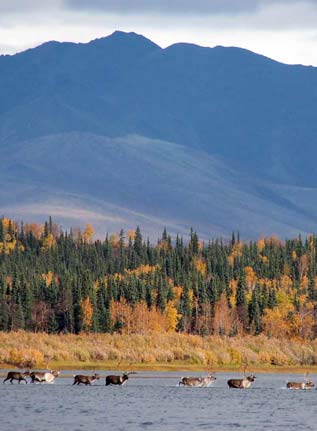
USFWS / Tina Moran
The Challenge
The majority of Alaska National Park units identify wildlife conservation as a central purpose in their founding legislation. Further, most of these lands are also designated wilderness where the National Park Service (NPS) is required to preserve naturalness. Thus maintaining and preserving natural populations, behaviors, and systems—that is, naturalness—is a core function of the Alaska region (Figure 2).
The responsibility to maintain natural wildlife populations is challenging due to both inherent and external factors. By their nature, populations of many wildlife species vary dramatically in response to natural ecological processes or as part of their life history (for example, caribou, lynx and hare). In addition, they migrate to and from parks both seasonally and as part of longer term range shifts (Figure 1). Climate dynamics will no doubt add to the complexity of wildlife population management in the future.
Because wildlife does not honor political boundaries, Alaska NPS shares management duties with others (federal agencies, the State of Alaska, Native organizations, private land owners, and our Canadian counterparts). Over the past decade, the State of Alaska has emphasized the production of preferred game species through liberalized predator harvest and management programs (Figure 3). This approach is difficult to rectify with the NPS mandate to maintain natural processes.

NPS Photo / Bob Winfree
Wildlife Stewardship on NPS Lands in Alaska
Recognizing the challenges described above, an interdisciplinary group convened in the winter of 2012 to develop a single source for consolidated guidance on the NPS’s roles and responsibilities regarding wildlife stewardship in Alaska. Participating members from the NPS included staff from the Alaska and Midwest regions, the Washington, D.C., office, and the Biological Resources Management Division. Disciplines represented included regional directorate members, superintendents, biologists, social scientists, program managers, law enforcement, solicitors, subsistence specialists, and university faculty. Hilderbrand and Joly et al.
(2013) developed a peer-reviewed report following the meeting to serve as a focused reference on Alaskan wildlife stewardship for NPS staff as they evaluate the myriad issues and decisions facing the agency and the wildlife held in its trust.
Key findings from the report include:
- the NPS is an ecosystem steward and this role extends to all components of the ecosystem, both living and nonliving, and the processes that link them (Figure 4)
- the primary objective of the NPS in Alaska is to maintain natural processes, including the natural distributions, densities, age-class distributions, species assemblages, and behaviors of native species
- these responsibilities apply to all NPS lands (that is, parks, preserves, and monuments) equally and without exception
- sport and subsistence harvest are allowed on preserves and subsistence harvest is allowed within specified parks and monuments
- harvest activities must be consistent with NPS resource mandates and the duty to maintain natural processes supersedes harvest authorizations
- when uncertain, NPS should err on the side of conservation.
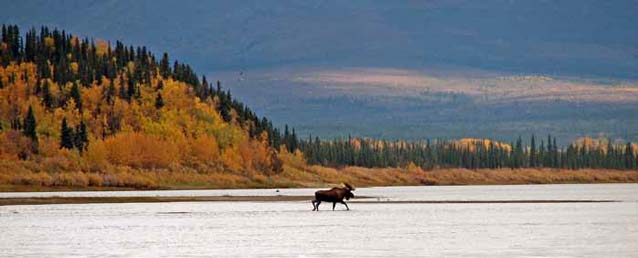
USFWS / Tina Moran
Wildlife Stewardship in Practice: The Case Study of Bear Baiting
The harvest of black bears (Figure 5) over bait under both state and federal regulations and on state and federal lands has long been legal in Alaska. In 2012, the State of Alaska authorized the harvest of brown bears over bait in portions of Alaska, including several national preserves. Prior to this regulatory change, the harvest of brown bears over bait was not legal in any North American state or province.
To evaluate the potential effects of this authorization on brown bear harvest on national preserves, Hilderbrand, Rabinowitch et al. (2013) evaluated the only relevant data available: historic harvest records of black bears over bait on National Park Service (NPS) lands. The authors concluded that there was little to no conservation concern as less than 2 black bears per year were harvested over bait during 1992-2010 on the 55 million acres of NPS lands in Alaska (Hilderbrand, Rabinowitch et al. 2013).

USFWS / Tina Moran
However, NPS has specific regulatory and policy guidance to:
- (1) prohibit the feeding of wildlife;
- (2) maintain natural behaviors; and
- (3) maintain natural ecological processes (36 CFR 2.2 (a)(2), NPS Management Policies 2006).
Further, both the General Authorities Act of 1978 and NPS Management Policies (2006) direct the NPS to promote “park values.” Thus, the data did not indicate any adverse impacts to bears at a population scale, but an explicit value decision remained.
A Rigorous and Objective Evaluation of a “Value” Issue
Recently, the field of conservation ethics and applied argument analyses has emerged as a way to address value-centered issues through an objective, transparent, and rigorous process. The North American model of wildlife management (Nelson et al. 2011), assisted colonization (Lawler and Olden 2011), reintroductions and wilderness (Vucetich et al. 2012), endangered species management and recovery (Vucetich et al. 2006, Carroll et al. 2010), sustainability (Vucetich and Nelson 2010), and ethics of animal research (Vucetich and Nelson 2007) have been informed by logic models and argument analysis.
The applied field of conservation ethics originates in the humanities, not in science, and addresses the fundamental question of what “should” or “ought” we do (Vucetich and Nelson 2012). Arguments constructed of premises and conclusions are developed through an iterative process. If all the premises are true or appropriate, no premises are missing, and the conclusion is supported by the premises, then a valid argument has been developed. Much like a scientific hypotheses, these arguments are never proven and can change through time as premises (for example, empirical, ethical, societal) change (Vucetich and Nelson 2012).
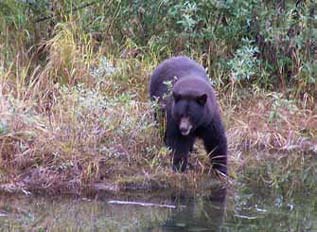
NPS Photo / Bob Winfree
The hunting of black bears over bait is an authorized harvest practice in many states and provinces in North America. The practice of bear baiting touches on a variety of social or ethical issues including fair chase, habituation, food-conditioning, public safety, and naturalness (Herrero 2002, Teel et al. 2002).
Due to these nonbiological complexities, the application of argument analyses was used as a tool to inform a wildlife regulatory decision. The initial argument was developed and shared with nine initial reviewers. Following iterative revision, the argument was sent to four additional reviewers. The reviewers included bear managers (including those managing bear baiting programs); bear researchers; state and federal agencies; universities; and the fields of ecology, wildlife management, and ethics. Following further revision, the argument was presented to the 22nd International Conference on Bear Research and Management held in Provo, Utah, in August of 2013. Comments and discussion at the conference led to further refinement and the argument that follows (Hilderbrand, in review):
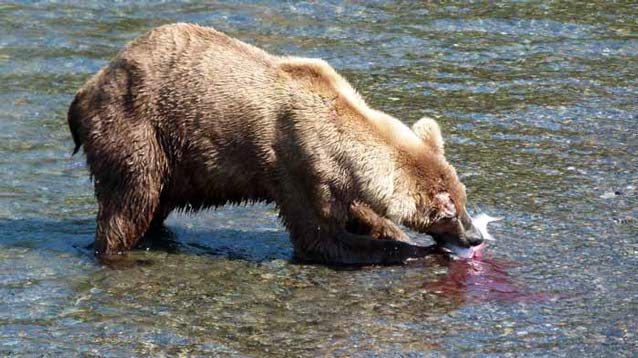
Courtesy Cindy Gonterman
The Argument
Empirical Premises
- Bears exhibit strong attraction to food (both natural and anthropogenic (Figure 6) and a variety of these food items can be used successfully as bait;
- The use of bait facilitates the harvesting of bears by predictably attracting them to a known location (Figure 7) and is thus essentially equivalent to other forms of food conditioning;
- Anthropogenic food-conditioned bears are more likely to be killed in defense of life or property than bears that are not conditioned to anthropogenic foods;
- Anthropogenic food-conditioned bears are more likely to pose a public safety risk than bears that are not conditioned to anthropogenic foods in areas where hunting or firearms are prohibited;
- Bears are successfully harvested without using bait, though baiting can greatly increase opportunity and success rate in some areas; and
- Feeding of wildlife is prohibited under state and NPS regulations.
Ethical Premises
- Creating unnecessary risks to bears, a public trust resource, should be avoided;
- Creating public safety risks should be avoided; and
- Natural animal behaviors and ecological processes should be maintained.
Societal Premises
- Bears have intrinsic value to humans (for example, cultural, economic, ecological);
- Opinions on hunting in general and bear hunting and use of bait specifically, vary; and
- Subsistence harvest is part of the natural processes of Alaska NPS units.
Conclusion: Use of bait should not be an allowed method of harvesting bears on NPS lands in Alaska.
Complex management decisions regarding our natural resources are derived from a combination of scientific information and social influences. Taken in total, the decision to prohibit the harvest of bears of either species over bait is logically and ethically sound. This outcome was largely driven by the desire to preserve naturalness, promote public safety, and maintain the value of bears as a public trust resource.
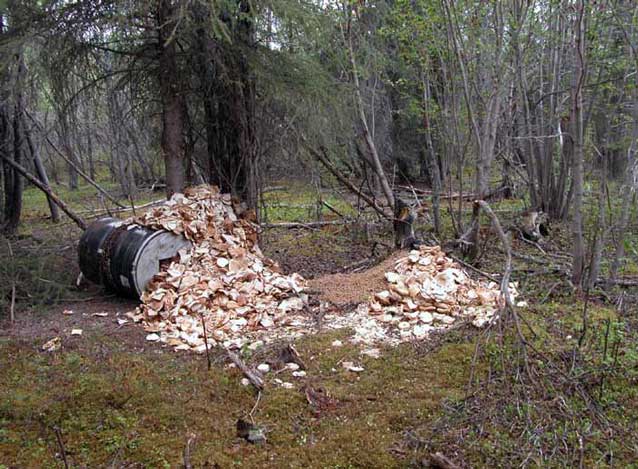
NPS Photo / Rich Richotte
Next Steps
The NPS has prohibited the harvest of brown bears over bait through formal closure provisions in federal statute and regulations since the authorization of the practice in 2012.
As part of the closure process, NPS provides notice, holds hearings, and receives public comment on proposed closures or restrictions. As part of these comments, numerous individuals have inquired about the appropriateness of the harvest of black bears over bait on NPS lands. The Alaska Region of NPS is currently developing a permanent regulations package addressing several wildlife harvest-related topics. As part of this process, we are explicitly requesting input from the public on the topic of brown and black bear harvest over bait. Thus, the decision to prohibit or allow this practice will likely be addressed definitively in the near future.
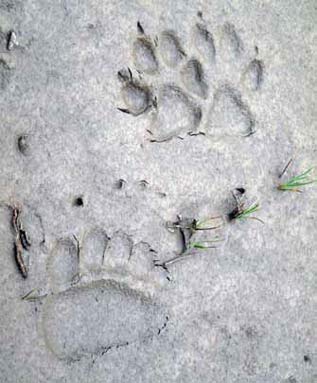
NPS Photo / Bob Winfree
Conclusions
As resource professionals, our typical role is to design research programs, collect and analyze scientific data, and then present and publish our work through credible professional organizations and journals.
The information is then used to support decisions that benefit the conservation of NPS natural resources and processes that link them. The ultimate goal, succinctly, is the preservation of populations, behaviors, and systems (that is, naturalness) (Figure 8).
However, the answer rarely, if ever, lies solely in the data. Often the question is not even one of biology, but rather one of values. In these cases, nonscientific tools such as argument analyses that are rigorous, transparent, and objective are available, appropriate, and informative. For natural resource professionals, using such tools may be the correct approach to support or enhance NPS decisions related to wildlife.
References
Carroll, C., J. Vucetich, M. Nelson, D. Rohlf, and M. Phillips. 2010
Geography and recovery under the U.S. Endangered Species Act. Conservation Biology 24:395-403.
Code of Federal Regulations.
Title 36: Parks, Forests, and Public Property. Washington, D.C.: Office of the Federal Registrar. U.S. Government Printing Office.
Herrero, S. 2002.
Bear Attacks: Their Causes and Avoidance. Guilford, Conn.: The Lyons Press.
Hilderbrand, G., K. Joly, S. Rabinowitch, and B. Shults. 2013.
Wildlife stewardship in National Park Service areas in Alaska: A report to the Alaska Leadership Council Sub-group on Wildlife Harvest on Parklands. Natural Resource Report NPS/AKSO/NRR-2013/663. Fort Collins: National Park Service.
Hilderbrand, G., S. Rabinowitch, and D. Mills. 2013.
Black bear baiting in Alaska and in Alaska’s National Park Service lands, 1992-2010. Ursus 24:91-96.
Lawler, J., and J. Olden. 2011.
Reframing the debate over assisted colonization. Frontiers in Ecology and the Environment 9:569-574.
National Park Service. 2006.
Management Policies. Washington D.C.: Department of the Interior. U.S. Government Printing Office.
Nelson, M., J. Vucetich, P. Paquet, and J. Bump. 2011.
An inadequate construct? North American model: What’s flawed, what’s missing, what’s needed. The Wildlife Professional 4:58-60.
Teel, T., R. Krannich, and R. Schmidt. 2002.
Utah stakeholders’ attitudes toward selected cougar and black bear management practices. Wildlife Society Bulletin 30:2-15.
Vucetich, J., and M. Nelson. 2007.
What are 60 warblers worth? Killing in the name of conservation. Oikos 116:1267-1278.
Vucetich, J., and M. Nelson. 2010.
Sustainability: virtuous or vulgar? Bioscience 60:539-544.
Vucetich, J., and M. P. Nelson. 2012.
A Handbook of Conservation and Sustainability Ethics. CEG Occasional Paper Series. Issue #1.
Vucetich, J. A., M. Nelson, and R. Peterson. 2012.
Should Isle Royal wolves be reintroduced? A case study on wilderness management in a changing world. George Wright Forum 29:126-147.
Vucetich, J., M. Nelson, and M. Phillips. 2006.
The normative dimension and legal meaning of Endangered and recovery in the U.S. Endangered Species Act. Conservation Biology 20:1383-1390.
Part of a series of articles titled Alaska Park Science - Volume 13 Issue 1: Wilderness in Alaska.
Last updated: August 5, 2015






